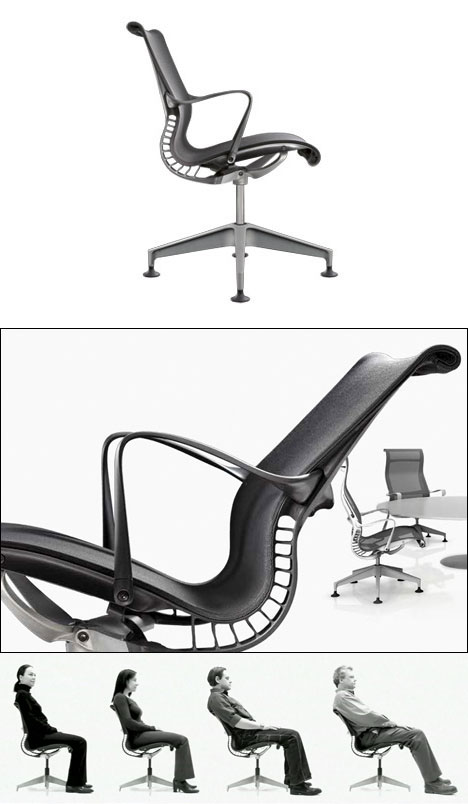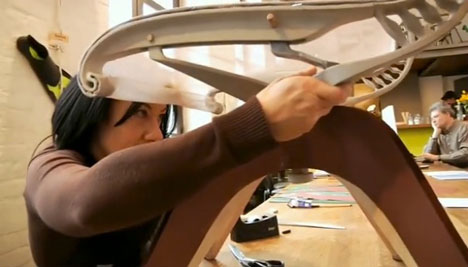Herman Miller's Setu Chair review
We take an in-depth look at Herman Miller's Setu Chair, a thoroughly modern piece of furniture designed for situations in which today's worker is far more likely to find themselves as opposed to even ten years ago.

An adjustable office chair is like the driver's seat of a car: If someone else has been using it, you spend the first few minutes adjusting its settings to fit you. I used to freelance out of an office with other temporary staff, where furniture would rotate in your absence; this made the first few minutes of each morning a maddeningly inconsistent experience, where you'd have to see which chair you'd been left with--the comfortable, coveted orange ones or the uncomfortable lavendar ones--and tweak some levers and knobs to get it to your liking.
It is precisely for flexible spaces like these that Herman Miller's Setu chair has been designed, by Berlin-based Studio 7.5.
Development "If you have a dedicated work chair that's your own, you can adjust that to your needs," says designer Carola Zwick. "But in most of the spaces you end up working in, there's not something like a dedicated work chair anymore.... You find yourself working in a cafe, or an airport, or a project or team space. In all of these cases, a chair with a lot of adjustments doesn't work."

The four-person firm, comprised of designers Burkhard Schmitz, Claudia Plikat, Carola Zwick, and engineer Roland Zwick, set out to design a chair that would be flexible in more ways than one--and that would come with no instruction manual. It would be simple, elegant and comfortable, with only one adjustable factor--chair height--and would provide all-day comfort to users of various sizes through its design.

"[Herman Miller's] development is design-driven and research-based," says Schmitz. Studio 7.5 followed suit, along with their philosophy that furniture design must be a hands-on, 3D experience; they cranked out 35 fully-functioning prototypes before they had something they were ready to show.

The result is a chair with a seemingly simple wave contour and an eye-catching feature--the "kinematic spine" transitioning from the seat to the seatback:

This ladder-like piece provides structure at rest and bends when weight is applied to it, obviating the need for a metal hinge and springs.
There is a single small, unobtrusive button on the side of the chair to adjust the height, and that's it--no levers, no knobs, no protruding metal rods. "The quest was always to make it as simple as possible," says Carola. "There's almost no area where I cannot give you the reason why the shape is like this, and needs to be this way."
"We tried to start with a clean slate and then find the form through the constraints," adds Schmitz.
Review Here are our findings from roughly three months of putting the chair through its paces. (And as with any test of comfort, we always recommend you visit a showroom to see for yourself due to different body sizes and preferences, etc.)
First and foremost, the all-important lumbar support is perfectly placed, providing firm support without being overly insistent about it. The curve of the chair back is, indeed, about more than looks. ("There is a very high amount of ergonomic knowledge built into the chair," says Plikat, "but you would maybe not notice." We noticed.) The comfort level alone easily makes this an all-day chair.
The elastomeric mesh is perfectly tuned in terms of give; I find it extremely comfortable precisely because I cannot really feel it. As I type this, if I sit perfectly still I cannot tell where exactly the chair is coming into contact with my body; I find myself seated in an ergonomically proper position, almost like I'm floating in space. This is a nice sensation, and void of any "dead spots" you'll often feel in a foam chair or a cheaper chair with inferior mesh tuning.
The armrests seem improbably thin and ribbon-like, and I worried they'd be flimsy; to my surprise they are quite rigid and barely flex when I put my full weight on them to raise myself from the chair. This is the only spot where I covet some adjustability as the placement is a little too low for me.
The kinematic spine works well, providing flex when you lean back and tilting the seat up slightly. I've observed that this angle of flex changes depending on one's size and weight; lighter sitters will not receive the same depth of incline as heavier ones. Other Findings There comes a time in every workday when, despite my best efforts at maintaining good posture, I scooch forward in the chair and slouch, with my ass off the very front of the seat and the back of my head resting on the top of the seatback. With many chairs this means I have the base of my skull pressing uncomfortably against a rigid piece of plastic or metal, but with the Setu it rests comfortably in the hammock-like mesh. I realize this is not at all how one is supposed to sit in a chair, as I am very nearly falling off of it, but thought I'd include it in case any of you have the same 5 o'clock habit.
Sometimes I come into my office from the shop, covered in sawdust but needing to check an e-mail. In these instances, and having a choice of chairs to sit in, I always chose to sit in the Setu because it simply does not pick up and show dust like other chairs.
Those in hotter climes will also appreciate the mesh; when coming in sweaty after a workout or on very hot days, the breathable mesh of the Setu is far more comfortable to sit in than in much more expensive fabric-covered chairs, and it became my seat of choice during the hot summer months.
The chair is surprisingly lightweight, especially when compared to, say, the Embody and the is-this-made-out-of-uranium Aeron. This may not matter to you, but once I day I have to lift the chairs in my space over to a platform to avoid entangling a Roomba. Anyone who needs to move and lift these chairs on a regular basis will appreciate the ease with which it can be done.
Summary At nearly half the price of a well-kitted Aeron, the Setu provides an economically feasible way to stock an entire office with comfortable, cutting-edge-design chairs without the sticker shock. The Setu will also make sense for consumers looking to furnish the home office on a budget.
However, what we're really hoping is that the Setu catches on not just in offices, but in the aforementioned public spaces where we often find ourselves working these days. Studio 7.5 has put roughly five years of work into this chair, and it would be nice to see it pay dividends in years of comfortable sitting for the masses, both inside offices and out.
The Setu's retail link is here, and below is a video on the "Making of the Setu."
Herman Miller's Making of Setu from hello on Vimeo.
-
oFavorite This
-
QComment
K
{Welcome
Create a Core77 Account
Already have an account? Sign In
By creating a Core77 account you confirm that you accept the Terms of Use
K
Reset Password
Please enter your email and we will send an email to reset your password.
